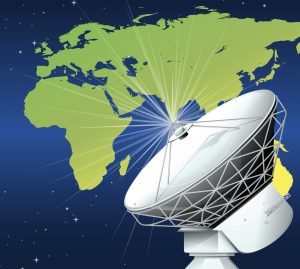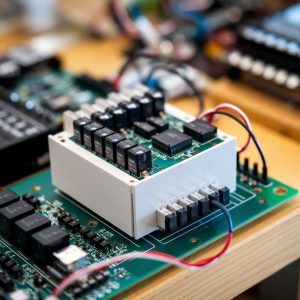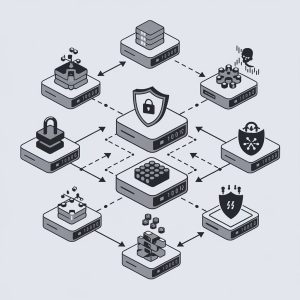Items of № 5, 2024
A METHODOLOGICAL APPROACH TO ASSESSING THE EMC OF BASE STATIONS OF THE LAND MOBILE SERVICE AND ONBOARD EQUIPMENT OF A RADIO ENGINEERING SYSTEM FOR SHORT-RANGE NAVIGATION AND LANDING
S.V. Shepelev, JSС MTU Saturn, deputy general director for special works; sshepelev@k-tech.ru
V.S. Ivanyuk, JSC MTU Saturn, deputy head of the EMC RES analysis center; vivanyuk@k-tech.ru
V.A. Grigoriev, Laboratory of Infocommunication Networks LLC, general director, ITMO National Research University, professor, Dr.Sci.(Tech.); vgrig@labics.ru
M.V. Korotkov, JSC MTU Saturn, head of the direction of the EMC RES analysis center, Ph.D.; mkorotkov@k-tech.ru
The article justifies and proposes a methodological approach to assessing the electromagnetic compatibility of radio electronic means of base stations of the land mobile service and on-board equipment of the near navigation and landing radio engineering system. The directional pattern of base stations’ antennas in the vertical plane and the effect of group action are taken into account.
Keywords: electromagnetic compatibility, near navigation radio systems, on-board equipment, land mobile service, base stations.
FREQUENCY SPECTRUM FOR FUTURE 6G SYSTEMS AND ELECTROMAGNETIC COMPATIBILITY CHALLENGES
A.S. Pastukh, FSBI NIIR, head of laboratory; apastukh@lenta.ru
A.N. Kostin, Geyser-Telecom, Ltd., deputy head of department; kostin@g-tl.ru
E.E. Devyatkin, FSBI NIIR, director of Advanced wireless communication technologies research center, Ph.D.; edevyatkin@niir.ru
M.V. Strelets, Geyser-Telecom, Ltd., head of department, Ph.D.; mstrelets@g-tl.ru
The article explores the potential for providing frequency spectrum in upcoming systems based on 6G radio interface technology. A particular focus is placed on reviewing the studies within ITU-R in regards of investigation of identification possibilities of new frequency bands for IMT in the WRC-27 study cycle. The article addresses issues related to potential electromagnetic compatibility issues between forthcoming 6G networks and existing radio services within the frequency ranges of 4400–4800 MHz, 7125–8400 MHz, and 14.8–15.35 GHz. Additionally, it analyzes potential challenges that might arise in implementing these bands for 6G in the Russian Federation.
Keywords: WRC-27, ITU-R, 6G, IMT-2030, 4400–4800 MHz, 7125–8400 MHz, 14.8–15.35 MHz, FSS, SRS, air mobile service, AMS, marine mobile service, MMS.
RESEARCH ON THE NOISE IMMUNITY OF THE DEMODULATION ALGORITHM WITH DECORRELATION WHEN IMPLEMENTED ON A FIXED-POINT PROCESSOR
S.B.C. Ben Rejeb, Moscow Technical University of Communications and Informatics (MTUCI), postgraduate; sbenrezheb@yandex.ru
V.B. Kreyndelin, MTUCI, head of a department, professor, Dr.Sci.(Tech.); vitkrend@gmail.com
The Zero Forcing (ZF) algorithm, also known as the decorrelation demodulation algorithm, is widely used for signal processing in various communication systems, such as wireless networks and data transmission systems. The purpose of the study is to evaluate the efficiency of the ZF algorithm when operating on a fixed-point processor. To achieve this purpose, an analysis of the algorithm’s performance at different signal-to-noise ratios was conducted, and its characteristics were studied under conditions of limited precision in representing numbers with fixed-point arithmetic. The analysis results of noise immunity using QPSK and QAM-256 modulations are presented. A comparison of the noise immunity of the ZF algorithm is provided based on various lengths of integer and fractional part representations in the processor. This study is of practical significance for signal processing system developers as it helps understand the capabilities and limitations of the ZF algorithm when implemented on a fixed-point processor. It can serve as a basis for further research and development aimed at enhancing the noise immunity of communication systems.
Keywords: MIMO, Zero Forcing, QPSK, QAM, noise immunity, fixed point.
METHOD FOR CLUSTERING IN COMMUNICATION NETWORKS OF THE FIFTH AND SUBSEQUENT GENERATIONS BASED ON POPULATION DENSITY
M.V. Sharlaeva, The Bonch-Bruevich Saint-Petersburg State University of Telecommunications (SPbSUT), department of communication networks and data transmission, engineer, postgraduate; masha110.97@mail.ru
The article formulates the reasons for the need to change the structure of communication networks of the fifth and subsequent generations. In order to decentralize the network, it is proposed to improve the C-means fuzzy clustering algorithm due to the use of the DBSCAN density algorithm. The results of using the algorithm on synthetic datasets were obtained. The dependence of the digital cluster size on the population density and distribution of users was determined.
Keywords: ultra low latency communications, digital clusters, network decentralization, fuzzy C-means clustering method, DBSCAN density method.
APPLICATION OF NEURAL NETWORKS IN SMARTPHONES AND TABLETS ON MOBILE COMMUNICATION NETWORKS
V.O. Aksenov, Laboratory of Infocommunication Networks LLC, deputy general director; VAksenov@labics.ru
A.I. Babin, JSC MTU Saturn, head of department, Ph.D.; ABabin@k-tech.ru
V.A. Grigoriev, Laboratory of Infocommunication Networks LLC, general director, ITMO National Research University, professor, Dr.Sci.(Tech.); vgrig@labics.ru
S.V. Shepelev, JSC MTU Saturn, deputy general director for special works; SSHepelev@k-tech.ru
The article analyzes the features of using neural networks in smartphones and tablets for scenarios and solutions based on artificial intelligence and machine learning technologies on mobile communication networks. The global and domestic levels of development of neural processors, domestic developments of neural networks on smartphones and tablets and prospects for future mobile subscriber devices are studied.
Keywords: neural networks, neural processor, NPU, AI and ML applications.
NETWORK TRAFFIC PREDICTION USING ARIMA MODELS
A.A. Grebenshchikova, The Bonch-Bruevich Saint-Petersburg State University of Telecommunications (SPbSUT), department of information and communication systems, assistance lecturer; grebenshikova.aa@sut.ru
The autoregressive integrated moving average (ARIMA) model is considered for predicting Internet of Things network traffic. The ARIMA model is an important class of parametric models that allows you to describe non-stationary series. The ability of such a model to capture the following significant characteristics of time data is investigated: dependencies in the short and long terms, self-similarity on large time scales, and a high level of multifractality on small time scales.
Keywords: traffic prediction model, linear time series ARIMA mode, non-linear GARCH model, self-similarity, multifractality.
INFORMATION SECURITY IN THE DIGITAL ECONOMY AS A FACTOR OF NATIONAL SECURITY
Yu.I. Sineshchuk, Saint Petersburg University of State Fire Service of Emercom of Russia, professor, Dr.Sci.(Tech.); sinegal53@mail.ru
I.B. Saenko, FSBI Branch NIIR–LONIIR, senior researcher, S.M. Budyonny’s Military Academy of Communications, professor, Dr.Sci.(Tech.); ibsaen@mail.ru
A.V. Ermakov, M.K. Ammosov’s North-Eastern Federal University, rector’s adviser, FSBI Branch NIIR–LONIIR, head of a department, associate professor, Ph.D.; ermakov-it@yandex.ru
The article summarizes and concretizes the concepts used in the field of security at the system level, clarifies the composition of the basic, system-forming types of national security and the connections between them. A concept is proposed that describes the national security system of a state as a complex socio-cyberphysical system in which information security in the digital economy allows for the integration of efforts to ensure various types of national security into a single complex. The increasing role of information security in the digital economy in ensuring the entire range of types of national security is substantiated.
Keywords: security, digital economy, technosphere, national security, information security.
EXPERIMENTAL RESEARCH METHODOLOGY OF THE DETECTABILITY OF MOBILE DEVICE UNDER ANDROID OS GEOLOCATION DATA SPOOFING
D.A. Borshchenko, Moscow Aviation Institute, student; borshenko2001@bk.ru
A.B. Roshchin, Moscow Aviation Institute, associate professor, Ph.D.; optimist2000@yandex.ru
The article is devoted to the development and testing of research methodology aimed at studying the possibility of detecting the fact of mobile device geolocation data spoofing. Methods for detecting software spoofing of geolocation data on Android-based mobile devices are analyzed, and methods for software detection of such substitutions are clarified. The article also presents the results of analytical work and approbation of the methodology for detecting the fact of spoofing geolocation data spoofing of smartphone geolocation data based on Android OS.
Keywords: information security, geolocation, geodata spoofing, privacy, mobile systems, mobile system security.
IMPROVING THE EFFICIENCY OF USING BIG DATA PROCESSING ALGORITHMS
D.O. Myrov, Russian University of Transport (MIIT), student; myrov.dima2016@yandex.ru
A.V. Gotin, Russian University of Transport (MIIT), student; art2003got@gmail.com
D.V. Kalkhitashvili, Russian Academy of National Economy and Public Administration, data directorate, senior analyst; Fullmetaltraumer@gmail.com
The article justifies the relevance of increasing the efficiency of using algorithms for processing large volumes of data. A modernized algorithm for collecting and processing information is presented, the advantages of the proposed algorithm are justified, and the benefits of choosing the Telegram API as a promising basis for interacting with users are discussed.structure of the methodology and its key stages are revealed. The issue of optimizing the information resources distribution after reconfiguration of the common information space is considered.
Keywords: efficiency, algorithm, processing large amounts of data, programming, services.









